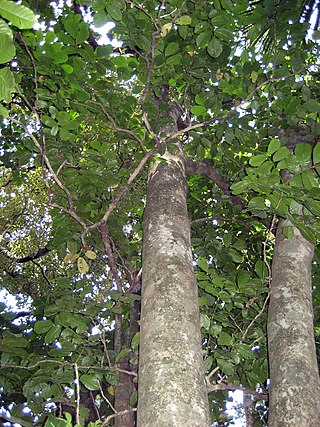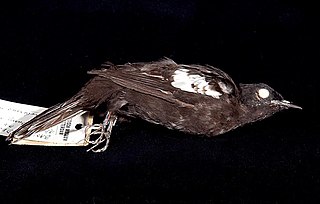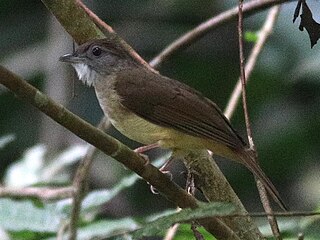
Wallacea is a biogeographical designation for a group of mainly Indonesian islands separated by deep-water straits from the Asian and Australian continental shelves. Wallacea includes Sulawesi, the largest island in the group, as well as Lombok, Sumbawa, Flores, Sumba, Timor, Halmahera, Buru, Seram, and many smaller islands. The islands of Wallacea lie between the Sunda Shelf to the west, and the Sahul Shelf including Australia and New Guinea to the south and east. The total land area of Wallacea is 347,000 km2 (134,000 sq mi).

Canarium is a genus of about 100 species of tropical and subtropical trees, in the family Burseraceae. They grow naturally across tropical Africa, south and southeast Asia, Indochina, Malesia, Australia and western Pacific Islands; including from southern Nigeria east to Madagascar, Mauritius, Sri Lanka and India; from Burma, Malaysia and Thailand through the Malay Peninsula and Vietnam to south China, Taiwan and the Philippines; through Borneo, Indonesia, Timor and New Guinea, through to the Solomon Islands, Vanuatu, New Caledonia, Fiji, Samoa, Tonga and Palau.

Dysoxylum is a flowering plant genus of trees and shrubs from the mahogany family, Meliaceae.

The bala shark also known as the tricolor shark, tricolor sharkminnow, silver shark, or shark minnow, is a fish of the family Cyprinidae, and is one of the two species in the genus Balantiocheilos. This species is not a true shark, but is commonly so called because of its torpedo-shaped body and large fins.

The Malayan civet, also known as the Malay civet and Oriental civet, is a viverrid native to the Malay Peninsula and the islands of Sumatra, Bangka, Borneo, the Riau Archipelago, and the Philippines. It is listed as "Least Concern" by IUCN as it is a relatively widely distributed, appears to be tolerant of degraded habitats, and occurs in a number of protected areas.

Kaloula baleata, the flower pot toad or sometimes the smooth-fingered narrow-mouthed frog, is a species of narrow-mouthed toad. It is native to India, Borneo, Indochinese Peninsula, Java, Malay Peninsula and Philippines where it lives in lowland rainforests and is tolerant of disturbed sites. The IUCN lists it as being of "Least Concern".

The long-billed partridge is a species of bird in the family Phasianidae.

Polypedates leucomystax is a species in the shrub frog family Rhacophoridae. It is known under numerous common names, including common tree frog, four-lined tree frog, golden tree frog or striped tree frog. Many past authors have united it with the common Indian tree frog in P. maculatus, but today they are generally considered distinct species. In its native range, it is also called "white-lipped tree frog", but this name is otherwise applied to a species of true tree frogs.

The grey-bellied bulbul is a species of songbird in the bulbul family. It is found on the Malay Peninsula, Sumatra and Borneo. Its natural habitat is subtropical or tropical moist lowland forests. It is threatened by habitat loss.

The black-and-white bulbul is a species of songbird in the bulbul family, Pycnonotidae. It is found on the Malay Peninsula, Sumatra, and Borneo. Its natural habitats are subtropical or tropical moist lowland forest and subtropical or tropical moist montane forest. It is threatened by habitat loss.

The cream-vented bulbul is a member of the bulbul family of passerine birds. It is found in south-eastern Asia from the Malay Peninsula to Borneo. Its natural habitat is subtropical or tropical moist lowland forests. Its breast might sometimes look a little yellow.

The hairy-backed bulbul is a songbird species in the bulbul family, Pycnonotidae. It is the sole species contained within the monotypic genus Tricholestes. It is found on the Malay Peninsula, Sumatra, and Borneo. Its natural habitat is subtropical or tropical moist lowland forests.

The Asian glossy starling is a species of starling in the family Sturnidae. It is found in Bangladesh, Brunei, India, Indonesia, Malaysia, Myanmar, the Philippines, Singapore, Taiwan (introduced) and Thailand. Its natural habitats are subtropical or tropical moist lowland forest and subtropical or tropical mangrove forest. There is also a huge number of this species inhabiting towns and cities, where they take refuge in abandoned buildings and trees. They often move in large groups and are considered one of the noisiest species of birds. In the Philippines, it is known as kulansiyang, galansiyang, or kuling-dagat.

The large woodshrike is found in south-eastern Asia, Sumatra, Java, and Borneo. Its natural habitats are temperate forest, subtropical or tropical moist lowland forest, subtropical or tropical mangrove forest, and subtropical or tropical moist montane forest.

The banded woodpecker or the banded red woodpecker is a species of bird in the family Picidae. It is found in Brunei, Indonesia, Malaysia, Myanmar, Singapore, and Thailand. Its natural habitats are subtropical or tropical moist lowland forests and subtropical or tropical mangrove forests.

Prevost's squirrel or Asian tri-colored squirrel is a colourful species of rodent in the family Sciuridae. It is found in forests in the Thai-Malay Peninsula, Sumatra, Borneo and nearby smaller islands, with an introduced population in northern Sulawesi. Although the Prevost's squirrel is declining in some regions because of habitat loss and hunting, the species is not considered threatened since it generally remains common and widespread. It can live in somewhat disturbed habitats and often visits plantations or gardens. It mostly feeds on plant material, especially fruits, but also takes insects.

The Malayan weasel or Malay weasel is a weasel species native to the Malay Peninsula and the islands of Sumatra and Borneo. It is listed as Least Concern on the IUCN Red List.

The Greater Sunda Islands are four tropical islands situated within Indonesian Archipelago, in the Pacific Ocean. The islands, Borneo, Java, Sulawesi and Sumatra, are internationally recognised for their ecological diversity and rich culture. Together with the Lesser Sunda Islands to their southeast, they comprise the archipelago known as the Sunda Islands.

The grey-cheeked bulbul is a species of songbird in the bulbul family, Pycnonotidae. It is found from the Malay Peninsula to the Greater Sunda Islands. Its natural habitats are subtropical or tropical moist lowland forests and subtropical or tropical moist montane forests.
Artocarpus teysmannii, also known as cempedak air in Malay and as tilap in Indonesia, is a species of flowering plant, a fruit tree in the fig family, that is native to Southeast Asia.




















